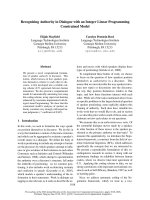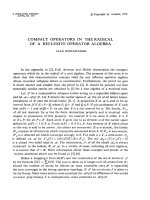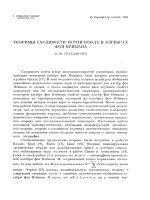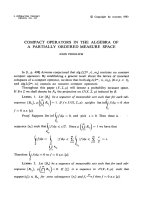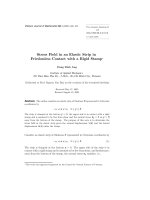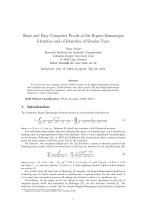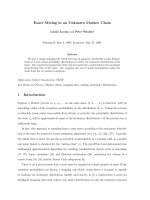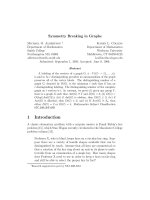Báo cáo toán học: "Short Cycles in Digraphs with Local Average Outdegree at Least Two" pptx
Bạn đang xem bản rút gọn của tài liệu. Xem và tải ngay bản đầy đủ của tài liệu tại đây (116.63 KB, 11 trang )
Short Cycles in Digraphs with
Local Average Outdegree at Least Two
Jian Shen
Department of Mathematics
Southwest Texas State University
San Marcos, TX 78666
Submitted: May 29, 2001; Accepted: Jun 17, 2003; Published: Jun 27, 2003
MR Subject Classifications: 05C20, 05C35, 05C38
Abstract
Suppose G is a strongly connected digraph with order n girth g and diameter
d.Weprovethatd + g ≤ n if G contains no arcs (u, v)withdeg
+
(u)=1and
deg
+
(v) ≤ 2.
Caccetta and H¨aggkvist showed in 1978 that any digraph of order n with min-
imum outdegree 2 contains a cycle of length at most n/2. Applying the above-
mentioned result, we improve their result by replacing the minimum outdegree con-
dition by some weaker conditions involving the local average outdegree. In partic-
ular, we prove that, for any digraph G of order n,ifeither
1. G has minimum outdegree 1 and deg
+
(u)+deg
+
(v) ≥ 4 for all arcs (u, v), or
2. deg
+
(u)+deg
+
(v) ≥ 3 for all pairs of distinct vertices u, v,
then G contains a cycle of length at most n/2.
1 Introduction
Let G =(V,E) denote a digraph on n = n(G) vertices. Loops are permitted but no
multiple arcs. All cycles considered here are directed cycles. If G has at least one cycle,
the minimum length of a cycle in G is called the girth of G, denoted g(G). On the other
hand, if G contains no cycles, the girth of G is defined to be infinity. The number of arcs
leaving (resp. entering) a vertex u is called the outdegree (resp. indegree)ofu, denoted
deg
+
(u) (resp. deg
−
(u)). A digraph G is said to be r-regular if the outdegree and indegree
of each vertex are both exactly r. The notation δ
+
(G) is used to denote the minimum
the electronic journal of combinatorics 10 (2003), #R26 1
outdegree of G. Suppose u, v are two vertices in a strongly connected digraph G.The
distance from u to v is the length of a shortest path from u to v in G.Thediameter of
G, denoted d(G), is the maximum distance among all ordered pairs of vertices in G.
In 1970, Behzad [1] proved that the girth of any 2-regular digraph of order n is at
most n/2. This bound is best possible in the sense that the girth of the Cayley digraph
Cay(Z
n
, {1, 2}) on a cyclic group (Z
n
, +) of order n is n/2. The regularity condition
can be relaxed however. For example, Caccetta and H¨aggkvist [4] made the following
improvement in 1978.
Lemma 1 The girth of any digraph of order n with δ
+
(G) ≥ 2 is at most n/2.
It is easy to see that any digraph G with δ
+
(G) ≥ 2 has a spanning subdigraph whose
each vertex has outdegree exactly 2. Since the girth of G is no larger than that of any of
its subdigraphs, the following lemma is equivalent to Lemma 1.
Lemma 1’ Suppose G is a digraph of order n with girth g.Ifdeg
+
(u)=2for each vertex
u in G, then g ≤n/2.
It is noted that Lemma 1 is a special case of the following well-known conjecture of
Caccetta and H¨aggkvist [4].
Conjecture 1 Let G be a digraph of order n with girth g and δ
+
(G) ≥ r. Then g ≤n/r.
The Caccetta-H¨aggkvist conjecture has been proved for r ≤ 5 by the work of various
authors [4], [6], [7]. Recently, the author showed that the conjecture holds when either
n ≥ 2r
2
− 3r + 1 [10] or n ≤ r(3 +
√
7)/2 [9]. While the general conjecture is still open,
it is worth mentioning the following result of Chv´atal and Szemer´edi [5].
Lemma 2 Let G be a digraph of order n with δ
+
(G) ≥ r. Then g ≤ n/r + 2500.
In 1988, Nishimura [8] refined the proof of Chv´atal and Szemer´edi, reducing the ad-
ditive constant in Lemma 2 from 2500 to 304. Recently, the author further reduced the
additive constant from 304 to 73 [11]. We mention here that Conjecture 1 is stronger
than a similar conjecture of Behzad, Chartrand and Wall [2] in which the digraphs are
assumed to be regular. For more details, we refer to [3] and [10].
Recently, the following extension of Lemma 1 was obtained in [10] by considering the
number of vertices in G with outdegree exactly 1.
the electronic journal of combinatorics 10 (2003), #R26 2
Lemma 3 Suppose G is a digraph of order n with girth g and δ
+
(G) ≥ 1.Lett
1
be the
number of vertices having outdegree exactly 1 in G. Then
g ≤
n/2 if t
1
=0
(n + t
1
− 1)/2 if t
1
≥ 1
The motivation of this paper is to improve Lemma 1 by replacing the condition
δ
+
(G) ≥ 2 by some weaker ones involving the local average outdegree. We begin with
an example below showing that a global average outdegree of at least 2 in a strongly
connected digraph of order n does not guarantee the existence of short cycles (cycles of
length at most n/2). Indeed the girth of such a digraph may be as large as n −
√
2n.
Example 1. Let n ≥ 7andr =
√
2n
+1. Then r ≤ n − 2. Let G =(V,E), where
V = {i :0≤ i ≤ n −1} and E = {(0,n−1)}∪{(i +1,i):r ≤ i ≤ n − 2}∪{(i, j):0≤
j<i≤ r}. Then the global average outdegree of G is
1
n
n−1
i=0
deg
+
(i)=
1
n
n − r +
r
i=1
i
=1+r(r − 1)/(2n) > 2
and the girth of G is n − r +1=n −
√
2n
.
Although the global average outdegree in Example 1 is larger than 2, the average
outdegree of the vertices i,1≤ i ≤ r, is as large as (r +1)/2, while the average outdegree
of the vertices i, r +1 ≤ i ≤ n − 1, is as small as 1. This unbalanced distribution
of outdegrees among all vertices in G makes the girth of G very large. Thus in order
to improve Lemma 1, one needs to consider certain local average outdegree conditions.
In particular, we consider in this paper the sums of outdegrees of each pair of adjacent
vertices in G.
An arc (u, v) ∈ E is called special if deg
+
(u) = 1 and deg
+
(v) ≤ 2. Thus, in any
digraph, the number of special arcs is at most the number of vertices with outdegree
exactly 1. Suppose G is a strongly connected digraph with global average outdegree 2.
Since the local average outdegree at each special arc is less than 2, the number of special
arcs in G may be considered as a rough measure of how balanced the distribution of the
outdegrees of G is. Thus one may expect that the number of special arcs in G has some
effect on the girth of G. Indeed, we suspect that the greater the number of special arcs
in G, the larger the possible girth of G may be.
In this paper, we first prove the following relationship,
d ≤ n −g + t,
among the diameter d, the order n, the girth g, and the number t of special arcs of any
strongly connected digraph. By using this result, we improve Lemma 3 by showing that,
the electronic journal of combinatorics 10 (2003), #R26 3
for any digraph with δ
+
(G) ≥ 1,
g ≤
n
2
if t =0,
n+t−1
2
if t ≥ 1.
In particular, if δ
+
(G) ≥ 1 and deg
+
(u)+deg
+
(v) ≥ 4 for all but at most one (u, v) ∈ E,
then g ≤n/2. We also show for any digraph G that, if deg
+
(u)+deg
+
(v) ≥ 3 for all
pairs of distinct vertices u, v in G,theng ≤n/2.
2 Main Results
Suppose u is a vertex in G. If a digraph G
is obtained from G by adding to it an extra
vertex u
and arcs {(u
,v):(u, v) ∈ E}∪{(v, u
):(v,u) ∈ E}∪{(u
,u)},wesaythatG
is obtained by using a copy transformation of G at vertex u, and we call the vertex u
a
copy vertex of u. It is straightforward, but a little tedious, to prove the following lemma.
We only prove the third statement which is a refinement of the following observation:
g ≤ d + 1 for all strongly connected digraphs.
Lemma 4 Suppose that G
is obtained by using a copy transformation of G at vertex u
and that u
is the copy vertex of u. Then the following Statement 1 holds. Moreover, if G
is strongly connected, then all the following statements hold.
1. The girth g(G
) of G
equals the girth of G.
2. The diameter d(G
) of G
is at least the diameter of G.
3. g(G
) ≤ d(G
).
4. If (v, u) ∈ E(G), then deg
+
G
(v)=deg
+
G
(v)+1≥ 2. (Thus no arc starting from v is
a special arc in G
although it may be special in G.)
5. deg
+
G
(u
) ≥ 2. (Thus Statements 4 and 5 imply that no arc associated with u
is
special in G
.)
6. All special arcs in G
are also special in G.(ThusG
contains no more special arcs
than G.)
Proof of Statement 3. Since G is strongly connected, the construction of G
shows
that G
is also strongly connected. Let u → u
1
→···→u
l−1
→ u
be a shortest path from
u to its copy vertex u
in G
. By the construction of G
,wehave(u
l−1
,u) ∈ E(G)andso
(u
l−1
,u) ∈ E(G
). Thus u lies on a cycle of length l in G
. Therefore g(G
) ≤ l ≤ d(G
).
✷
the electronic journal of combinatorics 10 (2003), #R26 4
Before stating the next theorem, we need some definitions. Suppose u is a vertex in
G. For any integer i ≥ 0, let D
i
(u) (resp. D
i
(u)) denote the set of vertices whose distance
from (resp. to) u is exactly i. In particular, D
0
(u)=D
0
(u)={u} since a vertex is at
distance 0 from and to itself. Let N
i
(u)=
i
j=0
D
j
(u), that is, N
i
(u) is the set of vertices
whose distance from u is at most i in G.
Theorem 1 Suppose G is strongly connected with order n,girthg and diameter d.IfG
contains no special arcs, then
d ≤ n − g.
Proof. Suppose Theorem 1 fails. Among all counterexamples with the minimum
number of vertices, we choose G to have the minimum number of vertices with outdegree
exactly 1. Let u be a vertex such that D
d
(u) = ∅. (This is possible by the definition
of the diameter.) The following facts are occasionally used in the proof: g ≤ d +1,
n =
d
j=0
|D
j
(u)|,andD
j
(u), 0 ≤ j ≤ d, are pairwise disjoint non-empty sets. We make
the following claims.
Claim 1: Suppose either |D
i−1
(u)| =1or|D
i
(u)| = 1 for some i,1≤ i ≤ g − 1. If
|N
i−1
(u)|≤
2g − 3if|D
i
(u)| =1,
2g − 4if|D
i
(u)|≥2, (thus |D
i−1
(u)| =1, )
then there are no arcs from D
i
(u)toN
i−1
(u) \{u}.
ProofofClaim1:Otherwise,suppose(v,w) ∈ E for some v ∈ D
i
(u)andsome
w ∈ N
i−1
(u) \{u}.LetG
1
be the subdigraph of G induced by N
i−1
(u) \{u}.LetG
2
be
obtained from G
1
by adding to it extra arcs (x, w) for all x ∈ D
i−1
(u) ∩ D
1
(v) \ D
1
(w).
Since either |D
i−1
(u)| =1or|D
i
(u)| = 1, it is easy to verify that, for all y ∈ N
i−1
(u)\{u} ,
deg
+
G
2
(y)=
deg
+
G
(y) −|D
i
(u)| if y ∈ D
i−1
(u) ∩ D
1
(v) ∩D
1
(w)and|D
i
(u)|≥2,
(thus |D
i−1
(u)| =1anddeg
+
G
(y) ≥|D
i
(u)| +1, )
deg
+
G
(y) −|D
i
(u)| +1 ify ∈ D
i−1
(u) ∩ D
1
(v) \D
1
(w)and| D
i
(u)|≥2,
(thus |D
i−1
(u)| =1anddeg
+
G
(y) ≥|D
i
(u)|, )
deg
+
G
(y) −1ify ∈ D
i−1
(u) ∩ D
1
(v) ∩D
1
(w)and|D
i
(u)| =1,
(thus deg
+
G
(y) ≥|D
i
(u)| +1=2, )
deg
+
G
(y) otherwise
≥ 1
Thus δ
+
(G
2
) ≥ 1 and so it is easy to see that g(G
2
) ≥ g−1. Let C be a strongly connected
component of G
2
such that C is also a sink of G
2
; that is, there are no arcs from C to
G
2
\C in G
2
.(IfG
2
itself is strongly connected, then C = G
2
.) Let
t =
0ifD
i−1
(u) ∩ D
1
(v) ∩ C = ∅,
1ifD
i−1
(u) ∩ D
1
(v) ∩ C = ∅ and |D
i
(u)| =1,
2ifD
i−1
(u) ∩ D
1
(v) ∩ C = ∅ and |D
i
(u)|≥2.
the electronic journal of combinatorics 10 (2003), #R26 5
Let G
3
be obtained by using t copy transformations of C at w. By Lemma 4, for all
y ∈ C,
deg
+
G
3
(y) ≥
deg
+
G
(y) −|D
i
(u)| + t ≥ 3ify ∈ D
i−1
(u) ∩ D
1
(v) ∩D
1
(w),
D
i−1
(u) ∩ D
1
(v) ∩C = ∅ and |D
i
(u)|≥2,
deg
+
G
(y) −|D
i
(u)| + t +1≥ 3ify ∈ D
i−1
(u) ∩ D
1
(v) \D
1
(w),
D
i−1
(u) ∩ D
1
(v) ∩C = ∅ and |D
i
(u)|≥2,
deg
+
G
(y) otherwise.
Also by Lemma 4, no arc associated with the copy vertices of w is special in G
3
and
g(C)=g(G
3
) ≤
d(G
3
)+1 if t =0,
d(G
3
)ift ≥ 1.
Since G contains no special arcs, G
3
contains no special arcs either. Since n(G
3
) ≤
|N
i−1
(u) \{u}| + t<|N
i−1
(u)| + |D
i
(u)| = |N
i
(u)|≤n, by the choice of G, G
3
is not a
counterexample to Lemma 1. Thus
d(G
3
) ≤ n(G
3
) − g(G
3
) ≤|N
i−1
(u) \{u}|+ t − g(G
3
)
≤|N
i−1
(u)| + t −1 −g(G
3
) ≤
2g − 4 − g(G
3
)ift =0,
2g − 3 − g(G
3
)ift ≥ 1.
Since d(G
3
) ≥
g(G
3
) − 1ift =0,
g(G
3
)ift ≥ 1,
we have g(G
3
) ≤ g − 2, a contradiction to g − 1 ≤ g(G
2
) ≤ g(C)=g(G
3
). Therefore
Claim 1 holds.
Claim 2: Suppose |N
i−1
(u)|≤2g − 5, |D
i
(u)| =3and|D
i+1
(u)| = 1 for some i,
1 ≤ i ≤ g − 2. Let D
i+1
(u)={v}.Ifdeg
+
(v) ≤ 2, then |D
i−1
(u)|≥2.
Proof of Claim 2: Otherwise suppose g ≥ 3and|D
i−1
(u)| = 1 for vertex x. Then, by
Claim 1, there are no arcs from D
i
(u)toN
i−1
(u) \{u}. Also there are no arcs from D
i
(u)
to u; otherwise G would contains a cycle of length i+1 ≤ g −1. Let D
i
(u)={w
1
,w
2
,w
3
}.
Suppose deg
+
(w
j
)=1forsomej,1≤ j ≤ 3. Then (w
j
,v) ∈ E since deg
+
(v) ≤ 2andG
contains no special arcs. Thus (w
j
,w
k
) ∈ E for some k = j,1≤ k ≤ 3. Since G contains
no special arcs, deg
+
(w
k
) ≥ 3. Recall that g ≥ 3 and that there are no arcs from w
k
to
N
i−1
(u). Then D
1
(w
k
)={v, w
1
,w
2
,w
3
}\{w
k
}.Thus(w
k
,w
j
) ∈ E, which together with
(w
j
,w
k
) ∈ E imply g = 2, a contradiction to g ≥ 3. Therefore it may be supposed that
deg
+
(w
j
) ≥ 2 for all j,1≤ j ≤ 3. But this implies that, starting from each vertex in
D
i
(u), there is an arc ends in D
i
(u)also. Thusg ≤|D
i
(u)| = 3, which implies g =3.
By the choice of G,wehaved>n− g =
d
j=0
|D
j
(u)|−3 ≥ d + |D
i
(u)|−3=d,a
contradiction, from which Claim 2 follows.
Claim 3: Suppose |N
i
(u)|≤2g − 3and|D
i+1
(u)| = 1 for some i,1≤ i ≤ g − 2. Let
D
i+1
(u)={v}.Ifdeg
+
(v) ≤ 2, then |D
i
(u)|≥3.
Proof of Claim 3: Otherwise suppose g ≥ 3and| D
i
(u)|≤2. Let X = N
i
(u) \{u}.
Then there are no arcs from X to u; otherwise G would contain a cycle of length at most
the electronic journal of combinatorics 10 (2003), #R26 6
i +1≤ g − 1. Let G(X) be the subdigraph of G induced by X.Thendeg
+
G(X)
(w) ≥ 1
for each vertex w ∈ D
i
(u); otherwise (w, v) is the unique arc starting from w in G and
so (w, v) would be a special arc of G, a contradiction. Thus δ
+
(G(X)) ≥ 1. For each
w ∈ D
i
(u), let w
t
be a terminus of w in G(X); that is, (w, w
t
)isanarcinG(X). Let
G
1
be the digraph obtained by using a sequence of copy transformations of G at each
vertex in {w
t
: w ∈ D
i
(u)}. By Lemma 4, g(G
1
)=g(G(X)) ≥ g.SinceG contains no
special arcs, each possible special arc in G(X) is associated with at least one vertex in
D
i
(u). By Lemma 4 again, G
1
contains no special arcs. Let C be a strongly connected
component of G
1
such that C is a sink of G
1
.ThenC has order n(C) ≤|X| + |D
i
(u)|
and girth g(C) ≥ g(G
1
) ≥ g.Notethatn(C) ≤|X| + |D
i
(u)|≤
i
j=1
|D
j
(u)| +2 ≤
g−1
j=0
|D
j
(u)|≤
d
j=0
|D
j
(u)|≤n. Suppose n(C)=n.Theni +1=g − 1=d.This
implies deg
+
G
(v) = 1 since, by replacing i by i + 1 in Claim 1, there are no arcs from
D
i+1
(u)={v} to N
i
(u) \{u} = N
d−1
(u) \{u} = V \{u, v} in G.ThuseitherC has order
less than G or C has fewer vertices with outdegree exactly 1 than G does (since v ∈ C).
This implies that C is not a counterexample to Lemma 1. Thus d(C) ≤ n(C) − g(C) ≤
|X|+|D
i
(u)|−g(C) ≤|N
i
(u)|+|D
i
(u)|−1−g(C) ≤ 2g −2−g(C). Since g(C)−1 ≤ d(C),
we have g(C) −1 ≤ d(C) ≤ 2g −2−g(C); i.e., g(C) ≤ g −1, a contradiction to g(C) ≥ g.
Therefore Claim 3 follows.
Claim 4: Suppose |N
g
(u)|≤2g −1. Then either |N
i
(u)|≥2i +1 or|N
i+1
(u)|≥2i +3
for all i,0≤ i ≤ g − 1.
Proof of Claim 4: Claim 4 is trivial for i =0and1. Lett be the first possible i,
2 ≤ i ≤ g − 1, satisfying |N
i
(u)|≤2i and |N
i+1
(u)|≤2i + 2. By the choice of t,wehave
2 ≤ t ≤ g − 1and|N
t−1
(u)|≥2t − 1. Then |D
t
(u)| = 1; otherwise if |D
t
(u)|≥2, then
|N
t−1
(u)| = |N
t
(u)|−|D
t
(u)|≤2t − 2, a contradiction. Thus |N
t−1
(u)| =2t − 1since
2t −1 ≤|N
t−1
(u)| = |N
t
(u)|−|D
t
(u)|≤2t −1. Also |D
t+1
(u)|≤
2if2≤ t ≤ g − 2,
1ift = g − 1;
otherwise |N
t+1
(u)| = |N
t−1
(u)| + |D
t
(u)| + |D
t+1
(u)|≥
2t +3 if 2≤ t ≤ g − 2,
2g if t = g − 1,
contradicting either the choice of t or the assumption |N
g
(u)|≤2g −1. Let D
t
(u)={v}.
Since |N
t−1
(u)| =2t − 1 ≤ 2g − 3, by setting i = t in Claim 1, there are no arcs from
D
t
(u)={v} to N
t−1
(u) \{u}. Since there is no loop at v,wehave
D
1
(v) ⊆
D
t+1
(u)if2≤ t ≤ g − 2,
D
t+1
(u) ∪{u} if t = g − 1,
Thus deg
+
(v) ≤ 2 always holds. Since |N
t−1
(u)| =2t −1 ≤ 2g −3, by setting i = t −1in
Claim 3, |D
t−1
(u)|≥3. Thus |N
t−2
(u)| = |N
t−1
(u)|−|D
t−1
(u)|≤(2t − 1) − 3=2t − 4
and so t ≥ 3. If either |D
t−1
(u)|≥4or|D
t−2
(u)|≥2, then |N
t−3
(u)| = |N
t−1
(u)|−
|D
t−1
(u)|−|D
t−2
(u)|≤(2t − 1) − 5=2t − 6, which together with |N
t−2
(u)|≤2t − 4
contradict the choice of t.Thus|D
t−1
(u)| =3and|D
t−2
(u)| = 1. On the other hand,
since |N
t−2
(u)|≤2t −4 ≤ 2g −6, |D
t−1
(u)| =3,|D
t
(u)| =1anddeg
+
(v) ≤ 2, by setting
i = t −1 in Claim 2, we obtain |D
t−2
(u)|≥2, a contradiction to |D
t−2
(u)| = 1. Therefore
the electronic journal of combinatorics 10 (2003), #R26 7
Claim 4 follows.
Claim 5: d ≤ n + i −|N
i
(u)| for all i ≥ 0. To justify this, since n ≥|N
i
(u)|,itmaybe
supposed that i ≤ d − 1. Therefore n = |N
i
(u)| +
d
j=i+1
|D
j
(u)|≥|N
i
(u)| + d − i,from
which Claim 5 follows.
We are now ready to complete the proof. By setting i = g − 1 in Claim 4, we have
either |N
g−1
(u)|≥2g − 1or|N
g
(u)|≥2g; i.e.,
min{g − 1 −|N
g−1
(u)|,g−|N
g
(u)|} ≤ −g.
By setting i = g − 1andg, respectively, in Claim 5,
d ≤ n +min{g − 1 −|N
g−1
(u)|,g−|N
g
(u)|} ≤ n − g.
This completes the proof of Theorem 1. ✷
By the definition of the girth of a digraph, it is known that d ≥ g −1 for any strongly
connected digraph. The following construction shows that the bound d ≤ n − g in
Theorem 1 is tight for the case d ≥ g.Letn = d + g and d = g + s,wheres ≥ 0. Let
V (G)=V
1
∪ ∪ V
g
∪{u
2g +1
, ,u
n
},whereV
i
= {u
2i−1
,u
2i
} for all 1 ≤ i ≤ g.Let
E(G)=
∪
g−1
i=1
E(V
i
,V
i+1
)
∪
∪
n
i=2g− 1
E(u
i
,V
1
)
∪{(u
i
,u
i+1
):2g ≤ i ≤ n − 1},where
E(V
i
,V
i+1
) denotes the set of arcs from each vertex in V
i
to each vertex in V
i+1
.ThenG
has no special arcs. Also the girth of G is g, and the diameter is d, which is achieved by
the distance from u
2g −1
to u
n
.
If (u, v)isanarcinG,wecallv the terminus of (u, v). Since the number of special
arcs is less than the number of vertices with outdegree exactly 1 in any digraph, the
following Corollary 1 and Theorem 2 are improvement of [10, Theorem 1 and Theorem
2], respectively.
Corollary 1 Suppose G is a strongly connected digraph of order n with girth g and di-
ameter d.IfG contains t spec ial arcs, then d ≤ n − g + t.
Proof. Let u
1
,u
2
, ,u
s
be all termini of the special arcs in G. (A common terminus
of more than one special arc counts only once.) Then s ≤ t.LetG
be obtained by using
a sequence of copy transformations of G at each vertex in {u
1
,u
2
, ,u
s
}.ThenG
is
strongly connected of order n + s. By Lemma 4, G
has girth g,diameterd(G
) ≥ d and
contains no special arcs. By applying Theorem 1 to G
, d ≤ d(G
) ≤ n + s −g ≤ n + t −g.
✷
Theorem 2 Suppose G is a digraph of order n with girth g and δ
+
(G) ≥ 1.IfG contains
t special arcs, then
g ≤
n
2
if t =0,
n+t−1
2
if t ≥ 1.
the electronic journal of combinatorics 10 (2003), #R26 8
Proof. Without loss of generality, it may be supposed that G is strongly connected;
otherwise it suffices to consider a strongly connected component and also a sink of G.If
t = 0, then by Corollary 1, g −1 ≤ d ≤ n − g; i.e., g ≤n/2. Now suppose t ≥ 1. Let u
be the terminus of a special arc and let G
be obtained by using a copy transformation of
G at u.ThenG
is strongly connected of order n + 1 with girth g and t − 1 special arcs.
By Lemma 4 and Corollary 1, g = g(G
) ≤ d(G
) ≤ (n +1)− g +(t − 1) = n − g + t; i.e,
g ≤(n + t − 1)/2. ✷
Corollary 2 Suppose G is a digraph of order n with girth g and δ
+
(G) ≥ 1.IfG contains
at most one special arc, then g ≤n/2.
Proof. Since t ≤ 1, Corollary 2 follows immediately from Theorem 2. ✷
The following corollary shows that any digraph G with δ
+
(G) ≥ 1 contains short cycles
if the local average outdegree at each arc is at least 2.
Corollary 3 Suppose G is a digraph of order n with girth g and δ
+
(G) ≥ 1.Ifdeg
+
(u)+
deg
+
(v) ≥ 4 for all arcs (u, v) in G, then g ≤n/2.
Proof. Since deg
+
(u)+deg
+
(v) ≥ 4 for all arcs (u, v), G contains no special arcs.
Therefore Corollary 3 follows from Corollary 2. ✷
Remark 1. As shown by the following example, the condition δ
+
(G) ≥ 1 in Corollary 3
cannot be dropped. Let G =(V, E), where V = A ∪ B and E = {(u, v):u ∈ A and v ∈
B},whereA ∩ B = ∅, |B|≥4andA is not empty. Then deg
+
(u)+deg
+
(v) ≥ 4 for all
arcs (u, v)inG. However G does not even contain any cycles.
The following corollary shows that the condition δ
+
(G) ≥ 1 may be dropped if
deg
+
(u)+deg
+
(v) ≥ 3 for all pairs of distinct vertices u, v in G. Note that the lat-
ter condition implies that G has at most one vertex u such that deg
+
(u) ≤ 1. Thus such
adigraphG contains at most one special arc.
Corollary 4 Suppose G is a digraph of order n ≥ 2 with girth g.Ifdeg
+
(u)+deg
+
(v) ≥ 3
for all pairs of distinct vertices u, v in G, then g ≤n/2.
Proof. By Lemma 1, it may be supposed that there is a unique u such that deg
+
(u) ≤
1. If deg
+
(u)=1,thenG contains at most one special arc and so Corollary 4 follows
from Corollary 2. Now suppose deg
+
(u)=0. Thendeg
+
(v) ≥ 3 − deg
+
(u) = 3 for all
vertices v = u.LetG
be the subdigraph of G induced by V \{u}.ThenG
is a digraph
of order n − 1withδ
+
(G
) ≥ 2. Thus by Lemma 1, g ≤ g(G
) ≤(n −1)/2,fromwhich
Corollary 4 follows. ✷
the electronic journal of combinatorics 10 (2003), #R26 9
3 Conclusion and Open Problem
The Caccetta-H¨aggkvist Conjecture predicted a very interesting relationship among vari-
ous fundamental parameters of digraphs: the girth, the degree and the number of vertices.
It has been studied without general resolution since its appearance in 1978. Lacking ap-
propriate methods to prove it, people tend to consider more general problems, in which
the minimum outdegree condition δ
+
(G) ≥ r is relaxed so that it may be easier to em-
ploy induction and some other proof techniques. Given the above strategy, one could
expect that the most difficult part is to find an appropriate ‘generalized statement’. This
has led to a number of stronger conjectures (see [3], for example). Motivated by Corol-
lary 3, we present the following conjecture which is stronger than the Caccetta-H¨aggkvist
Conjecture.
Conjecture 2 Suppose G is a digraph of order n with girth g and δ
+
(G) ≥ 1.Ifdeg
+
(u)+
deg
+
(v) ≥ 2r for all arcs (u, v) in G, then g ≤n/r.
We conclude the paper with the following remarks:
Remark 2. By modifying the example in Remark 1, we note that the condition δ
+
(G) ≥ 1
in Conjecture 2 cannot be dropped.
Remark 3. The following family of digraphs has girth n/r and satisfies the weaker
condition that deg
+
(u)+deg
+
(v) ≥ 2r for all arcs (u, v) instead of the stronger one
δ
+
(G) ≥ r. Suppose g is even and 1 ≤ k ≤ r − 1. Let G =(V,E)withV = ∪
g
i=1
V
i
and E = {(u, v):u ∈ V
i
,v ∈ V
i+1
, 1 ≤ i ≤ g}, where addition is taken modulo g.If
|V
i
| =
r −k if i is odd,
r + k if i is even,
then G has girth g and satisfies deg
+
(u)+deg
+
(v)=2r for all arcs (u, v). However
δ
+
(G)=r − k<r. Therefore Conjecture 2 considers more digraphs than Conjecture 1.
Remark 4. It is possible to apply the techniques presented in the paper to prove Con-
jecture 2 for some other lower values of r; however, the author feels that some other new
techniques are needed in order to prove the general conjecture.
Acknowledgment I want to thank Professor Richard Brualdi and a referee for some
helpful suggestions and comments.
References
[1] M. Behzad, Minimally 2-regular digraphs with given girth, J. Math. S oc. Japan 25
(1973), 1-6.
the electronic journal of combinatorics 10 (2003), #R26 10
[2] M. Behzad, G. Chartrand and C. Wall, On minimal regular digraphs with given
girth, Fu nd. Math. 69 (1970), 227-231.
[3] J. A. Bondy, Counting subgraphs: A new approach to the Caccetta-H¨aggkvist con-
jecture, Discrete Math. 165/166 (1997), 71-80.
[4] L. Caccetta and R. H¨aggkvist, On minimal digraphs with given girth, Proc. 9th S-E
Conf. Combinatorics, Graph Theory and Computing (1978), 181-187.
[5] V. Chv´atal and E. Szemer´edi, Short cycles in directed graphs, J. Combin. Theory,
Ser. B 35 (1983), 323-327.
[6] Y. O. Hamidoune, A note on minimal directed graphs with given girth, J. Com-
bin. Theory Ser. B 43 (1987), 343-348.
[7]C.T.Ho´ang and B. Reed, A note on short cycles in digraphs, Discrete Math. 66
(1987), 103-107.
[8] T. Nishimura, Short cycles in digraphs, Discrete Math. 72 (1988), 295-298.
[9] J. Shen, Directed triangles in digraphs. J. Combin. Theory, Ser. B 74 (1998),
405-407.
[10] J. Shen, On the girth of digraphs. Discrete Math. 211(1-3) (2000), 167-181.
[11] J. Shen, On the Caccetta-Haggkvist conjecture, accepted by Graphs Combin. 18(3)
(2002), 645-654.
the electronic journal of combinatorics 10 (2003), #R26 11
